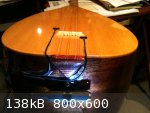| Pages:
1
2 |
Sazi
Oud Junkie
    
Posts: 786
Registered: 9-17-2007
Location: Behind my oud
Member Is Offline
Mood: مبتهج ; ))
|
|
One suggestion... swap that .008 for the .007 on the bass course, it makes sense to have the thicker string tuned to the lower pitch.
|
|
|
fernandraynaud
Oud Junkie
    
Posts: 1865
Registered: 7-25-2009
Location: San Francisco, California
Member Is Offline
Mood: m'Oudy
|
|
Thanks, Sazi.
Good idea, but I doubt the string will survive the operation, once bent they usually snap, in harpsichords anyway. I have a new set on order anyway.
Very hard to get credible info on string gauges. I just found I think the La Bella Saz set SA1 set on Justrings.com, and it looks like it only differs
in having 0.008" and 0.012" plain steel strings, instead of 0.007" and 0.011". Is that the famous 0.20? It would sort of match as 0.20 mm is about
0.008" and 0.18 mm is about 0.007".
So what exactly made you cut the neck, what was too hard about tuning or playing on long neck, and how did you do it and not lose the "pegbox"? For me
the long finger-reach makes it hard to play expressively (can't beat the oud for THAT). Oh, and here I though I was done with buying instruments for a
LITTLE while ...
|
|
|
Sazi
Oud Junkie
    
Posts: 786
Registered: 9-17-2007
Location: Behind my oud
Member Is Offline
Mood: مبتهج ; ))
|
|
LOL!! nice joke! nice joke!
I think you're right about the .18/.20mm guages there.
(Obviously not always, but)... the long-necked ones are more usually used for playing fast rhythmic folk-dance tunes, with much of the melodic stuff
done on the triple course, whereas on the shorter, melodies are played across all the strings, and can be very expressive, - check out Musa on the
tube.
Neck...how and why? ... well, I realised I preferred the Aşık style (as with the two players I mentioned), and that requires a short neck
and it's associated tuning, or 6' arms and 8" fingers on a long-neck, as you may have discovered... so not being able to find a short necked saz I
just cut out a section nearest the head and copied the original V shaped joint, (fiddly, requires lot's of patience and a large swear-box!) then of
course I had to re-adjust all the frets...I ended up with 17 frets, (an "octave" @ the last fret) instead of 19 because of the larger dimensions of
the body, but in practice, that's all that's really needed with that tuning and style.
Funny co-incidence, I gave it away a couple of years ago, but I just got it back on the weekend, a pleasant surprise, I sure missed it!
|
|
|
fernandraynaud
Oud Junkie
    
Posts: 1865
Registered: 7-25-2009
Location: San Francisco, California
Member Is Offline
Mood: m'Oudy
|
|
Sasha: "and PLEASEPLEASEPLEASE don't try to 'improve' the instrument"
Sazi: -- I just cut out a section nearest the head and copied the original V shaped joint, (fiddly, requires
lot's of patience and a large swear-box!) then of course I had to re-adjust all the frets...I ended up with 17 frets, (an "octave" @ the last fret)
instead of 19 because of the larger dimensions of the body
 and he though playing with a longer pick was heresy! and he though playing with a longer pick was heresy!
Another memorable quote (that might apply to ouds as well), from a certain "Bob" from the "All that Saz" tribe:
Basically you can keep buying sazes until you are broke; each one is different, each has its own personality.
He wrote an excellent explanation of the long vs. short neck saz:
http://tribes.tribe.net/saz/thread/dda3462d-1b29-452f-9e2c-9c1a0d41...
|
|
|
Sazi
Oud Junkie
    
Posts: 786
Registered: 9-17-2007
Location: Behind my oud
Member Is Offline
Mood: مبتهج ; ))
|
|
 ... it was definitely an improvement for me! ... it was definitely an improvement for me!
That Tribes article is a good summary, ...
" You can always tune a long neck to baglama tuning though with the greater distance between the frets it will be a bit more awkward when learning.
You can also capo it up but the sound is not always what you might want. "...
...Also, obviously, you can tune a bağlama to long-neck tuning, which having tried it both ways, for me is more useful/playable. My (very good
playing) Turkish friends tend to do that too.
" Another memorable quote (that might apply to ouds as well), "... No "might" about it, definitely!
|
|
|
fernandraynaud
Oud Junkie
    
Posts: 1865
Registered: 7-25-2009
Location: San Francisco, California
Member Is Offline
Mood: m'Oudy
|
|
You know, one thing I cannot fathom, is why people who play Saz talk about tunings without stating WHICH WAY they list the courses. So you don't know
if they mean high to low, or low to high. And on this instrument, with courses containing a bass string, you could get confused anyway. And to finish
off the total confusion, some people say "low" to refer to the course that is closer to the floor. I really don't like this one bit, for someone who's
trying to figure it out, or communicate with others, it's a pain.
In his post on the long vs. short neck, in discussing tuning, "Bob" switches "direction" in midstream but at least says once "the standard for music
is GDA from low to high, (for baglama, AGD)". Ah, so when he was talking ADG, higher up on the page, he was backwards. And are we sure that when he
says "high" he doesn't mean "closer to the ceiling"?
When you think about how the Turkish oud players read a G (Sol) on the staff and call it Rast, C (Do), but play a D, which brain-mash led to the
internationally distributed D'Addario J95 string set having totally absurd labeling, including insane miscalculated tension figures, you wonder if
this is a regional madness.
I mean, really, is it THAT impossible, if nothing else, to agree that we enumerate from player's head towards his foot, to use a convention like
A>G>D or La>Sol>Re, or to unambiguously specify Aa>gg>Ddd ?
|
|
|
fernandraynaud
Oud Junkie
    
Posts: 1865
Registered: 7-25-2009
Location: San Francisco, California
Member Is Offline
Mood: m'Oudy
|
|
Yo, Sazi, nice piece on the e-bow!
I just taped down the leads and screwed down the clip on the K&K classic-dual disk.

Sounds wonderful plugged into my little Gorilla GB-30, and doesn't need a preamp unless you want one. The timbre does not include a lot of the very
high end, but my DI setup has a lot of options, and it goes into Nuendo where everything is possible.
Now the looming issue is whether to get a short neck (baglama), or rather WHEN to get a short neck.
But explain one thing. Let's say the common long neck tuning is G>D>A, or in my case C>G>D, if I look at the shortneck A>G>D, the
most striking thing is that G>D is a fifth, meaning the top 2 courses are in fifths just like on longneck, so only the bottom A>G is out of
whack. What is so different then about playing with A>G>D tuning? The bass course being so close? How does that affect how you play, or am I
misunderstanding how you tune?
|
|
|
Sazi
Oud Junkie
    
Posts: 786
Registered: 9-17-2007
Location: Behind my oud
Member Is Offline
Mood: مبتهج ; ))
|
|
Thanx
Yes, I forgot to mention that I didn't usually use any pre with the twinspots, they sound great for saz just as they are.
You're not misunderstanding the tuning, just not familiar with the playing style, like I said, check out Arif and Musa, very educational..
You've noticed that the tunings are simply inversions... In the 80's there was a lot of folk/pop bands with saz ensembles containing 3 or 4 different
sizes all playing together, with the inversions lending an incredible richness, look for early Belkis Akkale to hear what I mean.
|
|
|
fernandraynaud
Oud Junkie
    
Posts: 1865
Registered: 7-25-2009
Location: San Francisco, California
Member Is Offline
Mood: m'Oudy
|
|
I just got some Saz longneck strings from a nice outfit called TouchTheEarth. I think the labeling clarifies a few things, so here is a scan of the
set with string gauge measurements in English and Metric.

One important detail is that the GDA tuning that has been mysteriously rising over the years is actually simply offset by the usual Turkish notation
offset, I don't think it's some arbitrary progressive "drift".
So although it's notated as Gg>dd>Aaa, it's really B(b)b(b)>ff>Ccc. Now THAT finally makes sense!
Of course, people always tune up or down a bit to accommodate a singer's optimal range, but it's nowhere near as arbitrary as some would have it.
The Baglama tuning would then also be called out one way but physically tuned higher, just like the Turkish oud is tuned higher and notated lower.
The labeling of the standard long neck "0.20" set is indeed based on the gauge in millimeters of the thinnest strings, so the 0.18 (I assume that's
the Baglama or short neck) would indeed be a little lighter. I don't have the tensions figured out yet at different scales etc, but at least it's
starting to make sense.
Common Long Neck Saz Strings and Tuning
(From Lowest > Highest , i.e. as on oud, from face to floor).
Tuned B(b) Wound 0.0232" (0.59 mm) Notated G
Tuned b(b) Plain 0.0085" (0.216 mm)
Tuned f Plain 0.0118" (0.30 mm) Notated D
Tuned f Plain 0.0118" (0.30 mm)
Tuned C Wound 0.0165" (0.41 mm) Notated A
Tuned c Plain 0.0078" (0.20 mm)
Tuned c Plain 0.0078" (0.20 mm)
|
|
|
tayfunozdemir
Oud Admirer

Posts: 1
Registered: 5-20-2019
Member Is Offline
|
|
I am a bit late on this thread (9 years!). Are the k&k's installed from inside (through the hole) or on the outside of the base-board? If inside,
exactly what location? On the top and bottom of the bridge?
|
|
|
| Pages:
1
2 |
|